Chevrolet K30 1999, K1500 1999, C1500 1999 User Manual

yellow blue
The 1999 Chevrolet C/K Full-Size Pickup Owner's Manual
1-1 Seats and Restraint Systems
This section tells you how to use your seats and safety belts properly. It also explains the air bag system.
2-1 Features and Controls
This section explains how to start and operate your vehicle.
3-1 Comfort Controls and Audio Systems
This section tells you how to adjust the ventilation and comfort controls and how to operate your audio system.
4-1 Your Driving and the Road
Here you'll find helpful information and tips about the road and how to drive under different conditions.
5-1 Problems on the Road
This section tells you what to do if you have a problem while driving, such as a flat tire or overheated engine, etc.
6-1 Service and Appearance Care
Here the manual tells you how to keep your vehicle running properly and looking good.
7-1 Maintenance Schedule
This section tells you when to perform vehicle maintenance and what fluids and lubricants to use.
8-1 Customer Assistance Information
This section tells you how to contact Chevrolet for assistance and how to get service and owner publications. It also gives you information on ªReporting Safety Defectsº on page 8-10.
9-1 Index
Here's an alphabetical listing of almost every subject in this manual. You can use it to quickly find something you want to read.
i
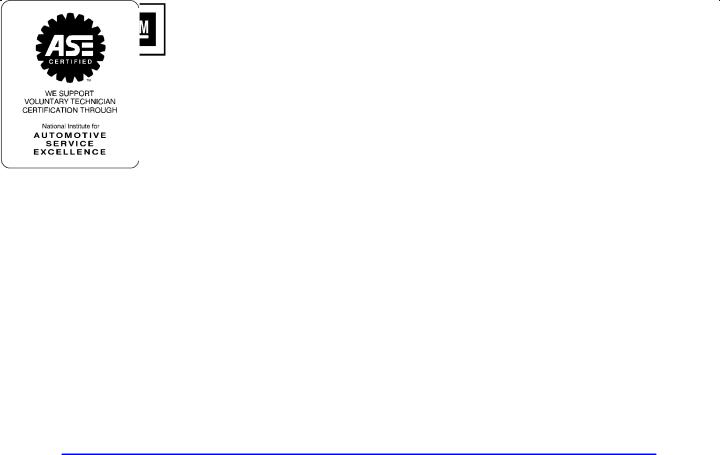
GENERAL MOTORS, GM, the GM Emblem, CHEVROLET and the CHEVROLET Emblem are registered trademarks of General Motors Corporation.
This manual includes the latest information at the time it was printed. We reserve the right to make changes in the product after that time without further notice. For vehicles first sold in Canada, substitute the name ªGeneral Motors of Canada Limitedº for Chevrolet Motor Division whenever it appears in this manual.
Please keep this manual in your vehicle, so it will be there if you ever need it when you're on the road. If you sell the vehicle, please leave this manual in it so the new owner can use it.
yellow blue
We support voluntary technician certification.
For Canadian Owners Who Prefer a
French Language Manual:
Aux propriétaires canadiens: Vous pouvez vous procurer un exemplaire de ce guide en français chez votre concessionaire ou au:
DGN Marketing Services Ltd.
1577 Meyerside Dr.
Mississauga, Ontario L5T 1B9
Litho in U.S.A. |
ECopyright General Motors Corporation 1998 |
C9904 B First Edition |
All Rights Reserved |
ii
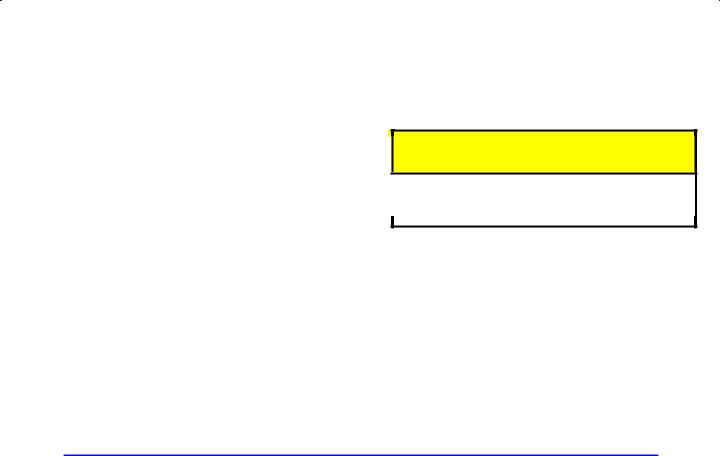
How to Use this Manual
Many people read their owner's manual from beginning to end when they first receive their new vehicle. If you do this, it will help you learn about the features and controls for your vehicle. In this manual, you'll find that pictures and words work together to explain
things quickly.
Index
A good place to look for what you need is the Index in back of the manual. It's an alphabetical list of what's in the manual, and the page number where you'll find it.
yellow blue
Safety Warnings and Symbols
You will find a number of safety cautions in this book. We use a box and the word CAUTION to tell you about things that could hurt you if you were to ignore the warning.
 CAUTION:
CAUTION:
These mean there is something that could hurt you or other people.
In the caution area, we tell you what the hazard is. Then we tell you what to do to help avoid or reduce the hazard. Please read these cautions. If you don't, you or others could be hurt.
iii
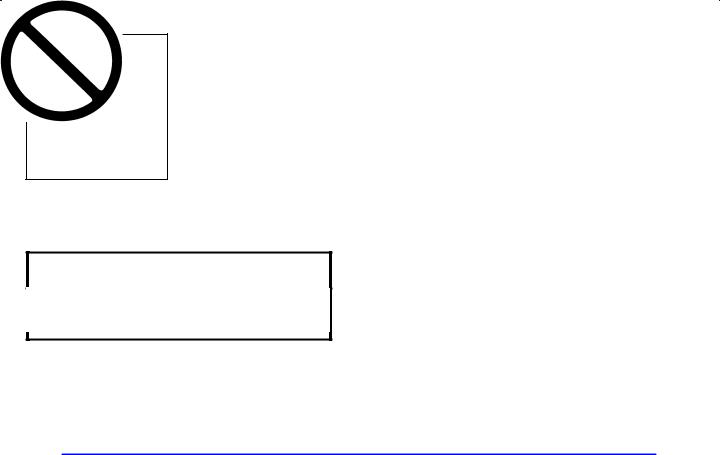
You will also find a circle with a slash through it in this book. This safety symbol means ªDon't,º ªDon't do thisº or ªDon't let this happen.º
Vehicle Damage Warnings
Also, in this book you will find these notices:
NOTICE:
These mean there is something that could damage your vehicle.
yellow blue
In the notice area, we tell you about something that can damage your vehicle. Many times, this damage would not be covered by your warranty, and it could be costly. But the notice will tell you what to do to help avoid the damage.
When you read other manuals, you might see CAUTION and NOTICE warnings in different colors or in different words.
You'll also see warning labels on your vehicle. They use the same words, CAUTION or NOTICE.
iv

yellow blue
Vehicle Symbols
These are some of the symbols you may find on your vehicle.
For example, these symbols are used on an original battery:
CAUTION
POSSIBLE
INJURY
PROTECT
EYES BY
SHIELDING
CAUSTIC
BATTERY
ACID COULD
CAUSE
BURNS
AVOID
SPARKS OR
FLAMES
SPARK OR
FLAME
COULD
EXPLODE
BATTERY
These symbols |
These symbols |
|
are important |
have to do with |
|
for you and |
your lamps: |
|
your passengers |
|
|
whenever your |
MASTER |
|
vehicle is |
||
LIGHTING |
||
driven: |
||
SWITCH |
||
|
||
DOOR LOCK |
TURN |
|
UNLOCK |
SIGNALS |
|
|
PARKING |
|
FASTEN |
LAMPS |
|
|
||
SEAT |
|
|
BELTS |
HAZARD |
|
|
WARNING |
|
|
FLASHER |
|
POWER |
DAYTIME |
|
WINDOW |
RUNNING |
|
|
LAMPS |
|
AIR BAG |
FOG LAMPS |
|
|
|
These symbols are on some of your controls:
WINDSHIELD
WIPER
WINDSHIELD
WASHER
WINDSHIELD
DEFROSTER
REAR
WINDOW
DEFOGGER
VENTILATING FAN
These symbols are used on warning and indicator lights:
ENGINE
COOLANT
TEMP
BATTERY
CHARGING
SYSTEM
BRAKE
COOLANT
ENGINE OIL
PRESSURE
ANTI-LOCK
BRAKES
Here are some other symbols you may see:
FUSE
LIGHTER
HORN
SPEAKER
FUEL
v
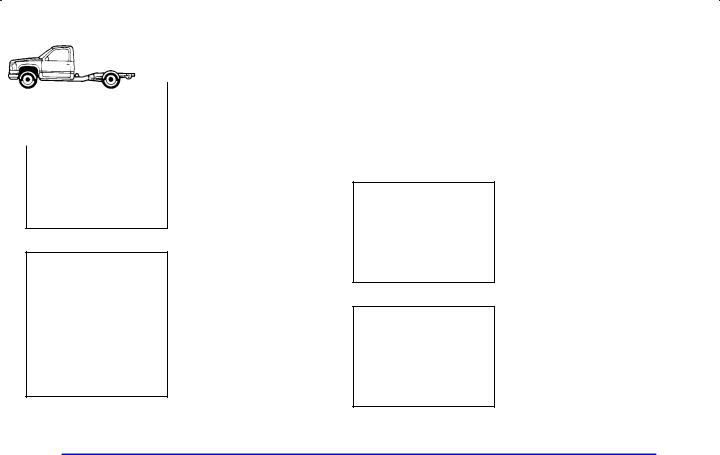
yellow blue
Model Reference
This manual covers these models: |
|
Crew Cab |
|
|
Regular Cab Pickup |
|
|
|
|
|
|
|
|
|
|
Chassis Cab
Extended Cab Pickup
3500 HD Chassis Cab
vi

yellow blue
Section 1 Seats and Restraint Systems
Here you'll find information about the seats in your vehicle and how to use your safety belts properly. You can also learn about some things you should not do with air bags and safety belts.
1-2 |
Seats and Seat Controls |
|
1-37 |
Rear Seat Passengers |
|
||||
1-9 |
Safety Belts: They're for Everyone |
|
1-43 |
Rear Safety Belt Comfort Guides for Children |
1-13 |
Here Are Questions Many People Ask About |
|
|
and Small Adults |
|
Safety Belts -- and the Answers |
|
1-45 |
Children |
1-14 |
How to Wear Safety Belts Properly |
|
1-48 |
Child Restraints |
1-14 |
Driver Position |
|
1-68 |
Larger Children |
1-22 |
Safety Belt Use During Pregnancy |
|
1-71 |
Safety Belt Extender |
1-23 |
Right Front Passenger Position |
|
1-71 |
Checking Your Restraint Systems |
1-23 |
Air Bag System |
|
1-71 |
Replacing Restraint System Parts |
1-35 |
Center Passenger Position |
|
|
After a Crash |
|
|
|
|
|
1-1
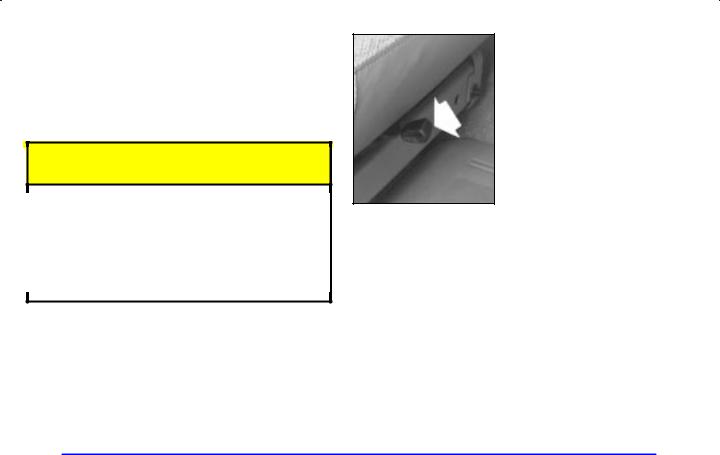
Seats and Seat Controls
This section tells you about the seats -- how to adjust them, and fold them up and down. It also tells you about reclining front seatbacks and head restraints.
Manual Front Seat
 CAUTION:
CAUTION:
You can lose control of the vehicle if you try to adjust a manual driver's seat while the vehicle is moving. The sudden movement could startle and confuse you, or make you push a pedal when you don't want to. Adjust the driver's seat only when the vehicle is not moving.
yellow blue
If your vehicle has a manual bucket, split bench or full bench seat, you can adjust it with this lever at the front of the seat.
Slide the lever at the front of the seat toward the passenger's side to unlock it. Using your body, slide the seat to where you want it. Then, release the lever and try to move the seat with your body in order to make sure the seat is locked into place.
1-2
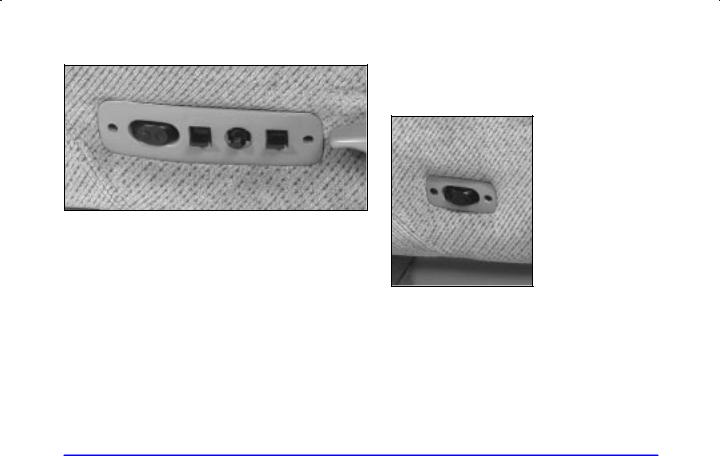
Power Driver's Seat (Option)
If your vehicle has a power seat on the driver's side, you can adjust it with these controls at the outside edge of the seat.
You can use the round center knob to move the seat to where you want it. To raise the seat, move the knob up. To lower the seat, move the knob down. To move the seat forward, move the knob toward the front of the vehicle. To move the seat rearward, move the knob toward the rear of the vehicle.
You can also raise and lower the front and rear of the seat. To raise the front of the seat, move the front lever up. To lower the front of the seat, move the front lever down. To raise the rear of the seat, move the rear lever up. To lower the rear of the seat, move the rear lever down.
yellow blue
The switch located at the front of this control panel is for the power lumbar adjustment, which is explained next.
Power Lumbar Control
If you have power lumbar adjustment, you can increase or decrease lumbar support in an
area of the lower seatback.
To increase support, press and hold the front of the rocker switch. Let go of the switch when the lower seatback reaches the desired level of support.
To decrease support, press and hold the rear of the rocker switch. Let go of the switch when the lower seatback reaches the desired level of support.
1-3
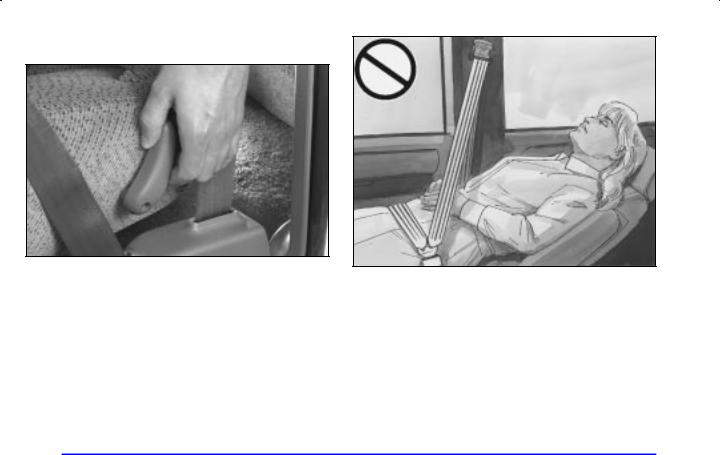
yellow blue
Reclining Seatbacks
To adjust the front seatback, move the lever rearward. Release the lever to lock the seatback where you want it. Move the lever again rearward and the seatback will go to an upright position.
But don't have a seatback reclined if your vehicle is moving.
1-4
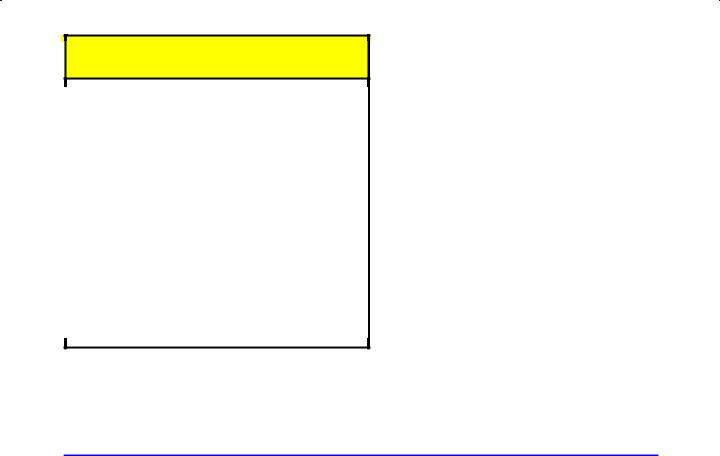
 CAUTION:
CAUTION:
Sitting in a reclined position when your vehicle is in motion can be dangerous. Even if you buckle up, your safety belts can't do their job when you're reclined like this.
The shoulder belt can't do its job because it won't be against your body. Instead, it will be in front of you. In a crash you could go into it, receiving neck or other injuries.
The lap belt can't do its job either. In a crash the belt could go up over your abdomen. The belt forces would be there, not at your pelvic bones. This could cause serious internal injuries.
For proper protection when the vehicle is in motion, have the seatback upright. Then sit well back in the seat and wear your safety belt properly.
yellow blue
Head Restraints
Slide the head restraint up or down so that the top of the restraint is closest to the top of your ears. This position reduces the chance of a neck injury in a crash.
Seatback Latches
The front seatback of the base level bench seat folds forward to let you access the rear of the cab. Your seatback will move back and forth freely, unless you come to a sudden stop. Then it will lock into place.
If you have a Crew Cab, your front seatback is designed not to fold forward. Access to the rear of the cab is available by using the rear doors.
The front seatback of split bench seat and bucket seats fold forward to let you access the rear of the cab.
1-5
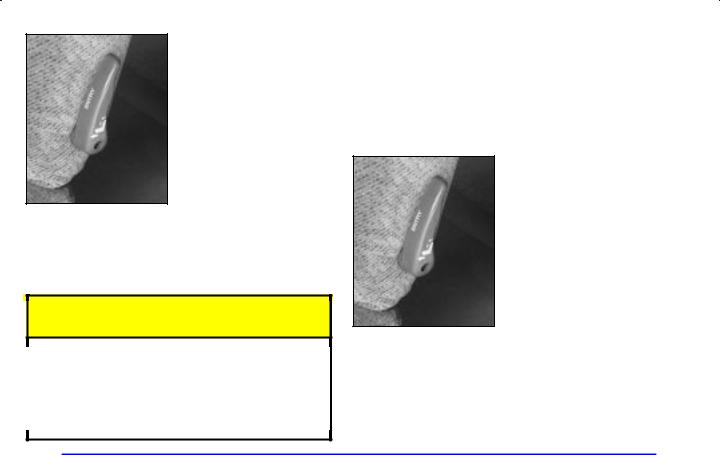
To fold a front split bench or bucket seatback forward, pull this lever forward and fold the seatback forward.
To return the seatback to the upright position, just push the seatback rearward until it latches. After returning the seatback to its upright position, pull the seatback forward to make sure it is locked.
 CAUTION:
CAUTION:
If the seatback isn't locked, it could move forward in a sudden stop or crash. That could cause injury to the person sitting there. Always press rearward on the seatback to be sure it
is locked.
yellow blue
Easy Entry Seat (Extended Cab Only)
The manual driver and passenger front bucket seats and the manual 60/40 split bench seat of your vehicle have an easy entry feature. This makes it easy to get in and out of the rear seat. On vehicles with the power driver's seat, only the front passenger's seat has the easy entry feature.
To operate the seat, pull forward on the top of this lever and tilt the back forward toward the front of the vehicle.
When you do, the seat bottom will release. Just pull or push the seat forward until it stops.
To return the seat to its regular position, return the seatback to its upright position, then push the whole seat rearward until it latches.
1-6
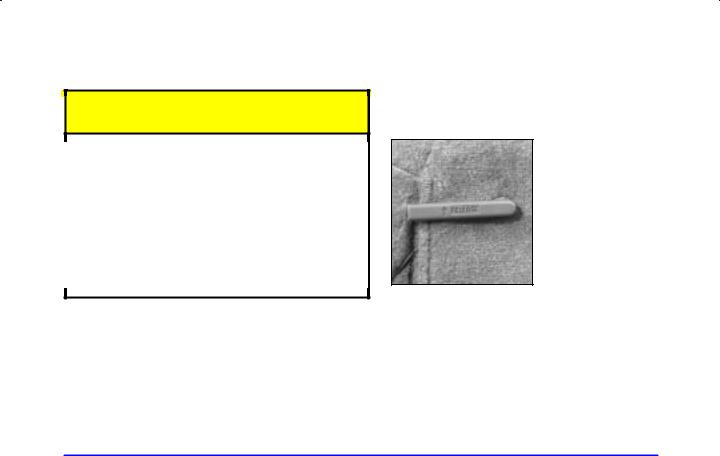
After returning the seat to its regular position, try to move the seat with your body to make sure the seat is locked into place.
 CAUTION:
CAUTION:
If any easy entry seat isn't locked, it can move. In a sudden stop or crash, the person sitting there could be injured. And, even if there is no crash or sudden stop, a driver sitting in an unlocked easy entry seat could be startled by the sudden movement and hit the wrong control or pedal, causing an accident. After you've used it, be sure to push rearward on any easy entry seat to be sure it is locked.
yellow blue
Rear Seat (Extended Cab)
Folding the Rear Seat
The extended cab may have a rear folding seat which can be folded up to provide more cargo space. To fold the seat:
1.Pull forward on the RELEASE lever under the seat cushion, behind the passenger's side front seat. Fold the seatback forward until it latches with the
seat cushion.
1-7
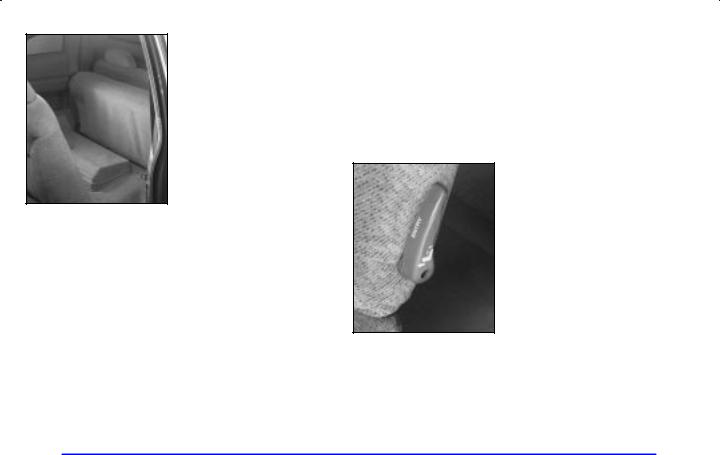
2. Lift the entire seat and push it rearward into place.
3. Make sure the seat is secure.
The extended cab's rear seat can also be unfolded for more seating space. To use the seat:
1.Pull the entire seat forward until it is flat.
2.Then pull forward on the RELEASE lever under the seat cushion, on the passenger's side of the rear seat. Push the seatback rearward until it latches.
3.After pushing the seatback upright into position, pull the seatback forward to make sure it is locked.
yellow blue
Rear Seat (Crew Cab)
The rear seatback without a center armrest can be folded forward to let you reach the area behind it. Your seatback will move back and forth freely, unless you come to a sudden stop. Then, it will lock into place.
The rear seatback with a center armrest folds forward to let you access the area behind it.
To fold a seatback forward, pull this lever forward and fold the seatback forward.
To return the seatback to the upright position, just push the seatback rearward until it latches. After returning the seatback to its upright position, pull the seatback forward to make sure it is locked.
1-8
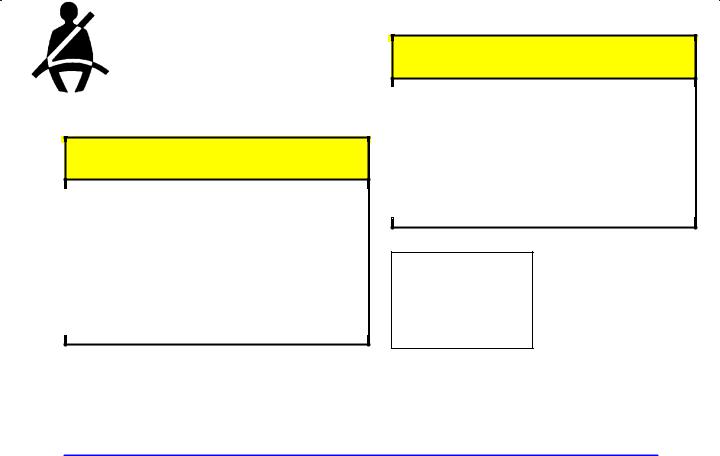
Safety Belts: They're for Everyone
This part of the manual tells you how to use safety belts properly. It also tells you some things you should not do with safety belts.
And it explains the air bag system.
 CAUTION:
CAUTION:
Don't let anyone ride where he or she can't wear a safety belt properly. If you are in a crash and you're not wearing a safety belt, your injuries can be much worse. You can hit things inside the vehicle or be ejected from it. You can be seriously injured or killed. In the same crash, you might not be if you are buckled up. Always fasten your safety belt, and check that your passengers' belts are fastened properly too.
yellow blue
 CAUTION:
CAUTION:
It is extremely dangerous to ride in a cargo area, inside or outside of a vehicle. In a collision, people riding in these areas are more likely to be seriously injured or killed. Do not allow people to ride in any area of your vehicle that is not equipped with seats and safety belts. Be sure everyone in your vehicle is in a seat and using a safety belt properly.
Your vehicle has a light that comes on as a reminder to buckle up. (See ªSafety Belt Reminder Lightº in the Index.)
1-9
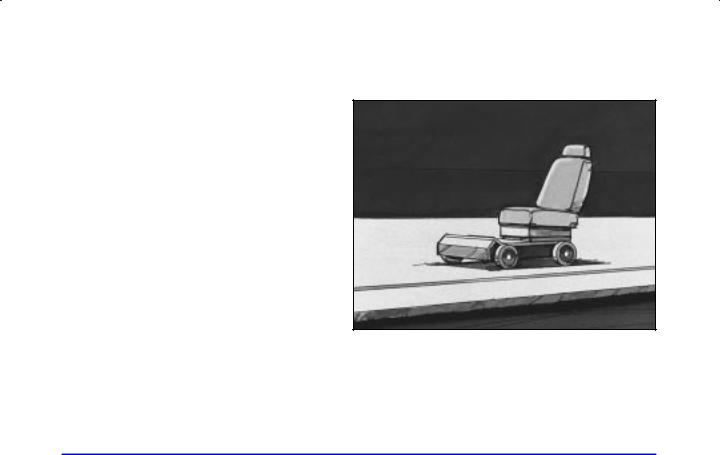
In most states and Canadian provinces, the law says to wear safety belts. Here's why: They work.
You never know if you'll be in a crash. If you do have a crash, you don't know if it will be a bad one.
A few crashes are mild, and some crashes can be so serious that even buckled up a person wouldn't survive. But most crashes are in between. In many of them, people who buckle up can survive and sometimes walk away. Without belts they could have been badly hurt
or killed.
After more than 30 years of safety belts in vehicles, the facts are clear. In most crashes buckling up does matter ... a lot!
yellow blue
Why Safety Belts Work
When you ride in or on anything, you go as fast as it goes.
Take the simplest vehicle. Suppose it's just a seat on wheels.
1-10
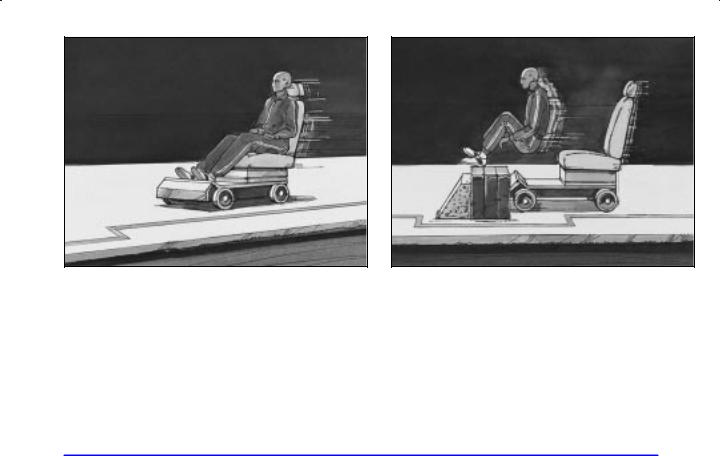
yellow blue
Put someone on it. |
Get it up to speed. Then stop the vehicle. The rider |
|
doesn't stop. |
1-11
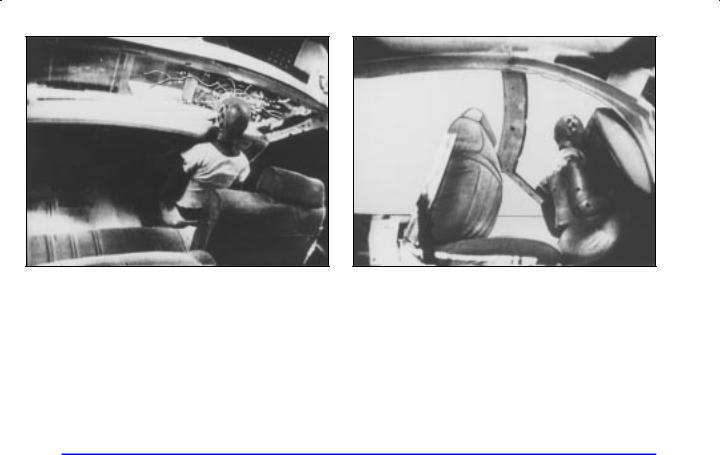
yellow blue
The person keeps going until stopped by something. |
or the instrument panel ... |
In a real vehicle, it could be the windshield ...
1-12
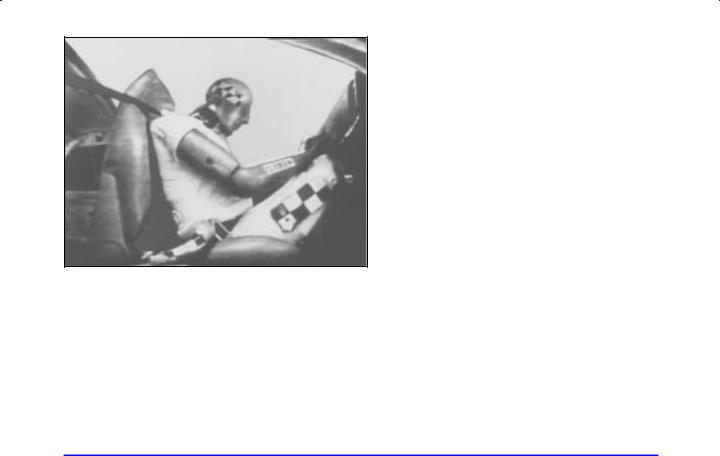
or the safety belts!
With safety belts, you slow down as the vehicle does. You get more time to stop. You stop over more distance, and your strongest bones take the forces. That's why safety belts make such good sense.
yellow blue
Here Are Questions Many People Ask About Safety Belts -- and the Answers
Q: Won't I be trapped in the vehicle after an accident if I'm wearing a safety belt?
A: You could be -- whether you're wearing a safety belt or not. But you can unbuckle a safety belt, even if you're upside down. And your chance of being conscious during and after an accident, so you can unbuckle and get out, is much greater if you are belted.
Q: If my vehicle has air bags, why should I have to wear safety belts?
A: Air bags are in many vehicles today and will be in most of them in the future. But they are supplemental systems only; so they work with
safety belts -- not instead of them. Every air bag system ever offered for sale has required the use of safety belts. Even if you're in a vehicle that has air bags, you still have to buckle up to get the most protection. That's true not only in frontal collisions, but especially in side and other collisions.
1-13

Q: If I'm a good driver, and I never drive far from home, why should I wear safety belts?
A: You may be an excellent driver, but if you're in an accident -- even one that isn't your fault -- you and your passengers can be hurt. Being a good driver doesn't protect you from things beyond your control, such as bad drivers.
Most accidents occur within 25 miles (40 km) of home. And the greatest number of serious injuries and deaths occur at speeds of less than 40 mph (65 km/h).
Safety belts are for everyone.
yellow blue
How to Wear Safety Belts Properly
Adults
This part is only for people of adult size.
Be aware that there are special things to know about safety belts and children. And there are different
rules for smaller children and babies. If a child will be riding in your vehicle, see the part of this manual called ªChildren.º Follow those rules for everyone's protection.
First, you'll want to know which restraint systems your vehicle has.
We'll start with the driver position.
Driver Position
This part describes the driver's restraint system.
Lap-Shoulder Belt
The driver has a lap-shoulder belt. Here's how to wear it properly.
1.Close and lock the door.
2.Adjust the seat (to see how, see ªSeatsº in the Index) so you can sit up straight.
1-14
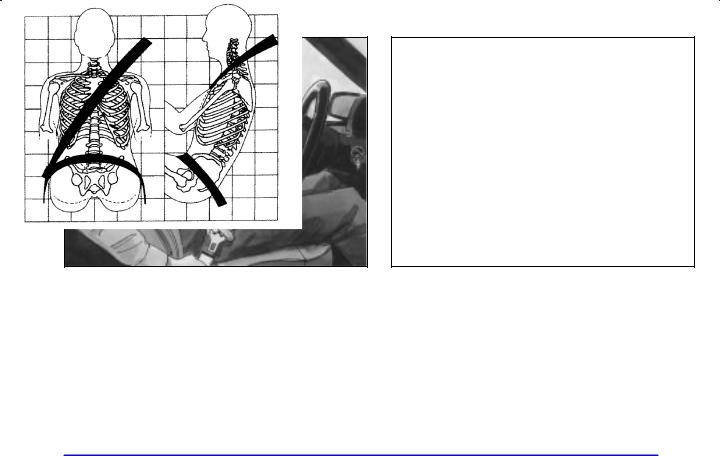
yellow blue
3.Pick up the latch plate and pull the belt across you. Don't let it get twisted.
4.Push the latch plate into the buckle until it clicks. Pull up on the latch plate to make sure it is secure.
If the belt isn't long enough, see ªSafety Belt Extenderº at the end of this section.
Make sure the release button on the buckle is positioned so you would be able to unbuckle the safety belt quickly if you ever had to.
The lap part of the belt should be worn low and snug on the hips, just touching the thighs. In a crash, this applies force to the strong pelvic bones. And you'd be less likely to slide under the lap belt. If you slid under it, the belt would apply force at your abdomen. This could cause serious or even fatal injuries. The shoulder belt should go over the shoulder and across the chest. These parts of the body are best able to take belt restraining forces.
The safety belt locks if there's a sudden stop or a crash.
1-15
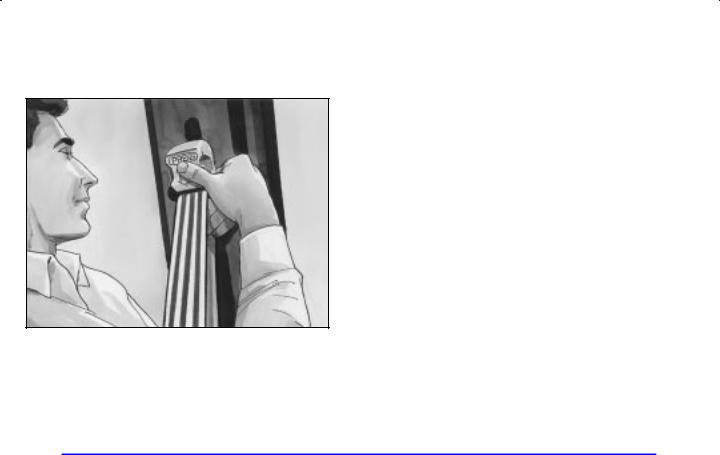
Shoulder Belt Height Adjuster
Before you begin to drive, move the shoulder belt adjuster to the height that is right for you.
yellow blue
To move it down, push in at the word PRESS and move the height adjuster to the desired position. You can move the adjuster up just by pushing up on the shoulder belt guide. After you move the adjuster to where you want it, try to move it down without pushing in to make sure it has locked into position.
Adjust the height so that the shoulder portion of the belt is centered on your shoulder. The belt should be away from your face and neck, but not falling off your shoulder.
1-16
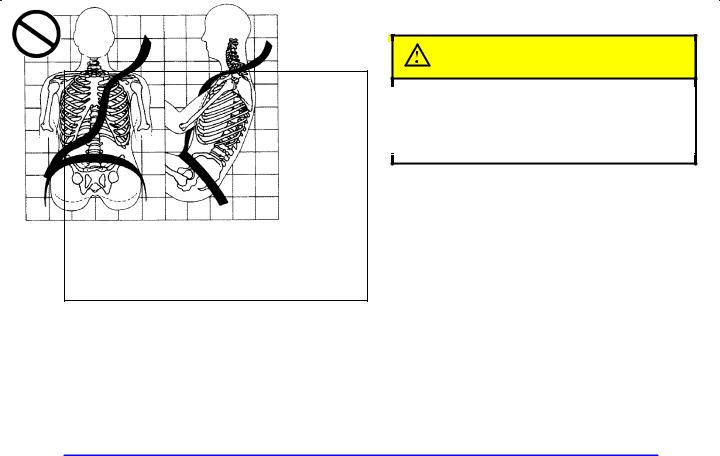
yellow blue
Q: What's wrong with this?
CAUTION:
You can be seriously hurt if your shoulder belt is too loose. In a crash, you would move forward too much, which could increase injury. The shoulder belt should fit against your body.
A: The shoulder belt is too loose. It won't give nearly as much protection this way.
1-17
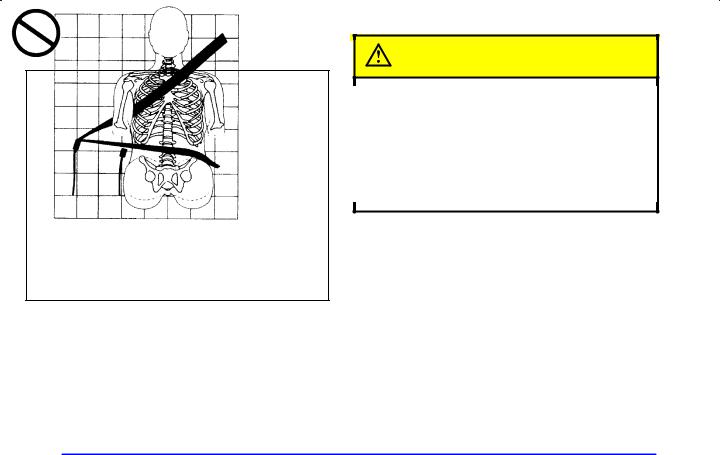
yellow blue
Q: What's wrong with this?
CAUTION:
You can be seriously injured if your belt is buckled in the wrong place like this. In a crash, the belt would go up over your abdomen. The belt forces would be there, not at the pelvic bones. This could cause serious internal injuries. Always buckle your belt into the buckle
nearest you.
A: The belt is buckled in the wrong place.
1-18
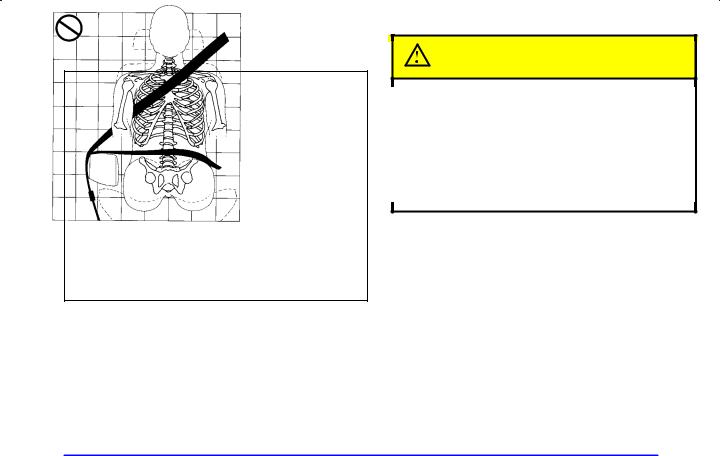
yellow blue
Q: What's wrong with this?
CAUTION:
You can be seriously injured if your belt goes over an armrest like this. The belt would be much too high. In a crash, you can slide under the belt. The belt force would then be applied at the abdomen, not at the pelvic bones, and that could cause serious or fatal injuries. Be sure the belt goes under the armrests.
A: The belt is over an armrest.
1-19
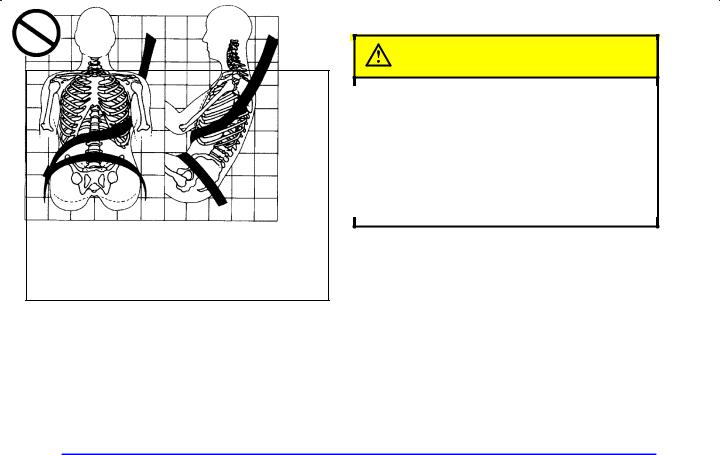
yellow blue
Q: What's wrong with this?
CAUTION:
You can be seriously injured if you wear the shoulder belt under your arm. In a crash, your body would move too far forward, which would increase the chance of head and neck injury. Also, the belt would apply too much force to the ribs, which aren't as strong as shoulder bones. You could also severely injure internal organs like your liver or spleen.
A: The shoulder belt is worn under the arm. It should be worn over the shoulder at all times.
1-20
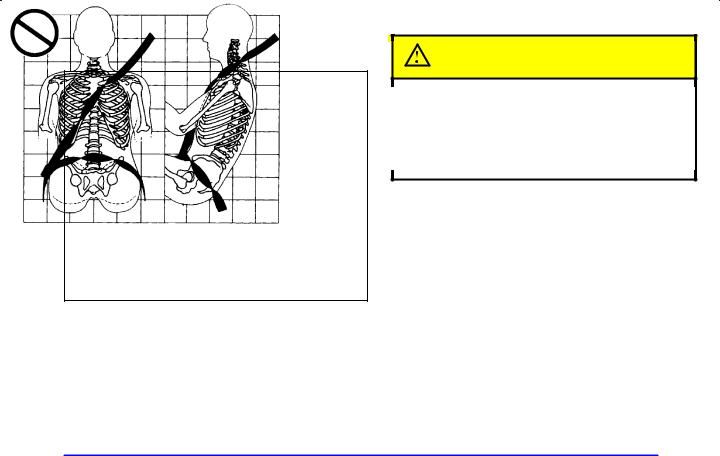
yellow blue
Q: What's wrong with this?
CAUTION:
You can be seriously injured by a twisted belt. In a crash, you wouldn't have the full width of the belt to spread impact forces. If a belt is twisted, make it straight so it can work properly, or ask your dealer to fix it.
A: The belt is twisted across the body.
1-21
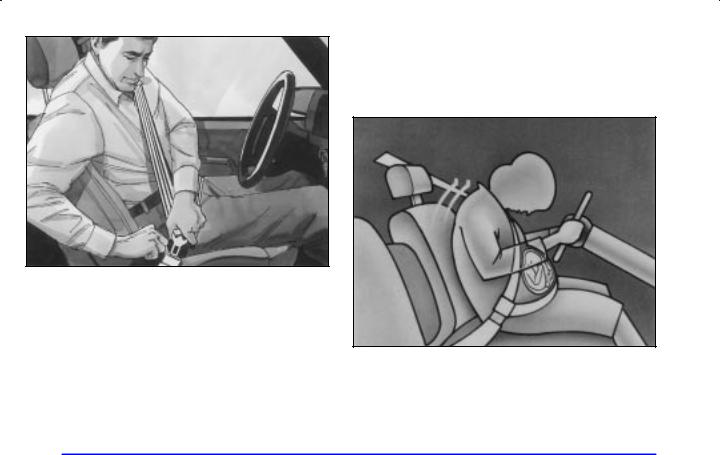
To unlatch the belt, just push the button on the buckle. The belt should go back out of the way.
Before you close the door, be sure the belt is out of the way. If you slam the door on it, you can damage both the belt and your vehicle.
yellow blue
Safety Belt Use During Pregnancy
Safety belts work for everyone, including pregnant women. Like all occupants, they are more likely to be seriously injured if they don't wear safety belts.
A pregnant woman should wear a lap-shoulder belt, and the lap portion should be worn as low as possible, below the rounding, throughout the pregnancy.
1-22

The best way to protect the fetus is to protect the mother. When a safety belt is worn properly, it's more likely that the fetus won't be hurt in a crash. For pregnant women, as for anyone, the key to making safety belts effective is wearing them properly.
Right Front Passenger Position
To learn how to wear the right front passenger's safety belt properly, see ªDriver Positionº earlier in
this section.
The right front passenger's safety belt works the same way as the driver's safety belt -- except for one thing. If you ever pull the lap portion of the belt out all the way, you will engage the child restraint locking feature. If this happens, just let the belt go back all the way and start again.
yellow blue
Air Bag System
This part explains the air bag system.
Your vehicle may have a ªNext Generationº frontal air bag for the driver and another ªNext Generationº frontal air bag for the right front passenger. If it does, it will say AIR BAG on the middle part of the steering wheel.
Next Generation frontal air bags are designed to help reduce the risk of injury from the force of an inflating air bag. But even these air bags must inflate very quickly if they are to do their job and comply with federal regulations.
1-23

Here are the most important things to know about the air bag system:
 CAUTION:
CAUTION:
You can be severely injured or killed in a crash if you aren't wearing your safety belt -- even if you have air bags. Wearing your safety belt during a crash helps reduce your chance of hitting things inside the vehicle or being ejected from it. Air bags are ªsupplemental restraintsº to the safety belts. All air bags -- even Next Generation air bags -- are designed to work with safety belts, but don't replace them. Air bags are designed to work only in moderate to severe crashes where the front of your vehicle hits something. They aren't designed to inflate at all in rollover, rear, side or low-speed frontal crashes. And, for unrestrained occupants, Next Generation air bags may provide less protection in frontal crashes than more forceful air bags have provided in the past. Everyone in your vehicle should wear a safety belt properly -- whether or not there's an air bag for that person.
1-24
yellow blue
 CAUTION:
CAUTION:
Air bags inflate with great force, faster than the blink of an eye. If you're too close to an inflating air bag, as you would be if you were leaning forward, it could seriously injure you. This is true even with Next Generation frontal air bags. Safety belts help keep you in position before and during a crash. Always wear your safety belt, even with Next Generation air bags. The driver should sit as far back as possible while still maintaining control of the vehicle.
